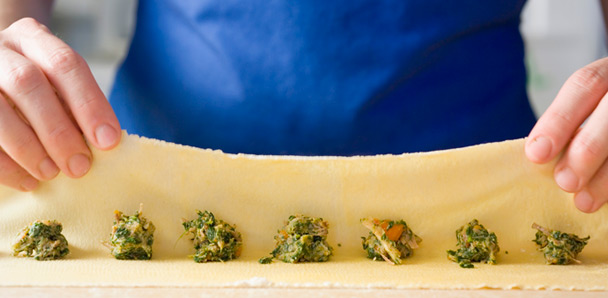Aim for delicate, light pasta that has a slight bite, which is achieved by rolling your pasta to a stage where you can almost see your hand through it. Remember that the thinner the dough, the more delicate the pasta. Rolling quantities may vary based on the initial texture of your dough, so use your judgment to gauge if fewer or more passes are required. (To help visualize this process, watch this technique video.)
Shaping the Pasta
Now it’s time to pick your shape. Do you need wide sheets for lasagna? Rounds for tortellini? Squares for ravioli? No matter how wacky your shape, all can be achieved starting with the basic wide sheet of pasta you create when rolling out the dough. Lasagna noodles, which are the exact, plain sheets sans any shaping, need nothing more than a quick blanch before lining a casserole dish.
Flat noodles are hand-cut by first laying the prepared pasta sheets on the table and sprinkling them with semolina flour. Rub the flour into the sheet of pasta to ensure it doesn’t stick to itself as you fold both ends in to the center of the sheet until they meet. Take the ends and fold them again so that they meet in the center. Turn the dough so that the fold is parallel to you, and using your chef’s knife, cut anywhere from 1/16- to 5/8-inch-wide strips. The width of your cut will determine whether you are making fettuccine (thin noodles), tagliatelle (thicker noodles), or papparadelle (thickest noodles). Once the cuts are made, use your fingers to separate the noodles and lay them on a baking sheet sprinkled heavily with semolina flour.

Shaping ravioli is just as simple; however, it requires a pastry bag, brush, and egg wash (1 egg beaten with 1 tablespoon water). Fill your pastry bag with your favorite ravioli filling then squeeze a quarter-size portion on the bottom half of the dough, leaving 1 inch between each portion (pictured above). Dip your brush into the egg wash and brush the wash along the top half of the dough and in between each portion of filling. Fold the dough over the pillows of filling, pressing the air out from the dough as you use your fingers to seal it. Cut between each portion of filling with a pastry wheel to create individual ravioli then lay the ravioli on a baking sheet sprinkled heavily with semolina flour until you’re ready to drop them into a pot of boiling salted water.
Although daunting at first thought, homemade pasta is made simple by knowing and understanding the proper proportions and techniques. Once you’ve prepared the pasta of your choice, all that’s left to do is to cook it until al dente, toss it with your favorite sauce, and then dig in.
The Institute of Culinary Education chef instructor Gerri Sarnataro grew up in Queens, New York, and has spent her entire adult life in Manhattan. Now, however, another place is competing with those deeply ingrained urban roots—Castiglione del Lago, in Umbria, home to her cooking school, Cucina della Terra.


 Pinterest
Pinterest


